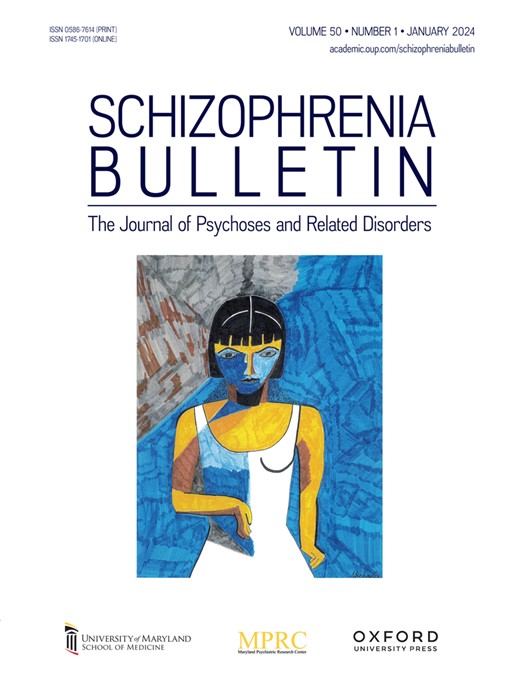Amygdala Function, Blood Flow, and Functional Connectivity in Nonclinical Schizotypy
IF 5.3
1区 医学
Q1 PSYCHIATRY
引用次数: 0
Abstract
Background and Hypothesis Schizotypy can be utilized as a phenotypic risk marker for schizophrenia and its spectrum and might relate to putative dimensional biological markers of the psychosis spectrum. Among these are amygdala function and structure, which are impaired in schizophrenia, but possibly also correlated with subclinical expression of schizotypy in nonclinical samples. We tested whether different parameters relating to amygdala function would be different in healthy subjects with relatively higher vs lower schizotypy traits. Study Design Sixty-three psychiatrically healthy subjects (42 with higher vs 21 with lower schizotypy scores, selected on the basis of the Oxford-Liverpool Inventory of Feelings and Experiences positive schizotypy subscale) underwent a multimodal imaging protocol, including functional magnetic resonance imaging (fMRI) during a task-based emotional (fearful) face recognition paradigm, arterial spin labeling for measurement of regional cerebral blood flow (rCBF) at rest, and resting-state fMRI for functional connectivity (FC) analyses, as well as a T1-weighted structural MRI scan. Study Results The high schizotypy group showed significantly higher right amygdala activation during viewing of fearful emotional images and lower resting-state FC of the left amygdala with a cerebellum cluster, but no differences in resting-state amygdala rCBF or volume. Conclusions Our findings demonstrate a functionally relevant effect of schizotypy on amygdala activation in the absence of baseline rCBF or macroscopic structure. This suggests that while schizotypy might affect some functional or structural parameters in the brain, certain functionally relevant effects only emerge during cognitive or emotional triggers.非临床分裂型的杏仁核功能、血流和功能连通性
背景与假设分裂型可以作为精神分裂症及其谱系的表型风险标记,并可能与精神病谱系的假定维度生物学标记有关。其中包括在精神分裂症中受损的杏仁核功能和结构,但也可能与非临床样本中分裂型的亚临床表达有关。我们测试了与杏仁核功能相关的不同参数在分裂型特征相对较高和较低的健康受试者中是否会有所不同。研究设计63名精神健康受试者(42名精神分裂症得分较高,21名精神分裂症得分较低)接受了多模式成像方案,包括在基于任务的情绪(恐惧)面部识别范式中进行功能磁共振成像(fMRI),动脉自旋标记用于测量休息时区域脑血流量(rCBF),静息状态fMRI用于功能连接(FC)分析,以及t1加权结构MRI扫描。研究结果高分裂型组在观看恐惧情绪图像时,右侧杏仁核激活显著增加,左侧杏仁核静息状态FC显著降低,伴有小脑簇,但静息状态rCBF和体积无差异。结论:我们的研究结果表明,在缺乏基线rCBF或宏观结构的情况下,分裂型对杏仁核激活的功能相关影响。这表明,虽然精神分裂可能会影响大脑的一些功能或结构参数,但某些功能相关的影响只会在认知或情感触发时出现。
本文章由计算机程序翻译,如有差异,请以英文原文为准。
求助全文
约1分钟内获得全文
求助全文
来源期刊

Schizophrenia Bulletin
医学-精神病学
CiteScore
11.40
自引率
6.10%
发文量
163
审稿时长
4-8 weeks
期刊介绍:
Schizophrenia Bulletin seeks to review recent developments and empirically based hypotheses regarding the etiology and treatment of schizophrenia. We view the field as broad and deep, and will publish new knowledge ranging from the molecular basis to social and cultural factors. We will give new emphasis to translational reports which simultaneously highlight basic neurobiological mechanisms and clinical manifestations. Some of the Bulletin content is invited as special features or manuscripts organized as a theme by special guest editors. Most pages of the Bulletin are devoted to unsolicited manuscripts of high quality that report original data or where we can provide a special venue for a major study or workshop report. Supplement issues are sometimes provided for manuscripts reporting from a recent conference.
 求助内容:
求助内容: 应助结果提醒方式:
应助结果提醒方式:


